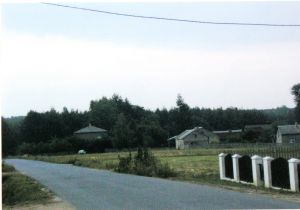Kowale Panskie ( Aka Czachulec Nowy)

Czachulec September 2005
Kowale Panskie is located 39 miles north- northwest of Lodz. The community consisted of sixteen hamlets centred on the village of Kowale Panskie. The Jewish ghetto that was established here during the Second World War is also sometimes referred to as Czachulec Nowy, the name of one of the main villages in the area. Until September 1939, only a few Jewish families lived in this mostly agricultural area. On 20 October 1941, approximately 3,700 Jews from Kreis Turek were deported to the rural sub-districts of Kowale Panskie and Malanow. These Jews mainly came from the communities of Brudzew, Dobra, Peczniew, Tuliszkow, Turek, Uniejow and Wladyslawow.
The Germans instructed the Jews in Turek to pack everything they had, including the bugs. As many families were without men, members of the Jewish Council (Judenrat) and Jewish Police assisted the women to pack up their things. From Turek and Dobra, long columns of Jews, four abreast, followed by wagons carrying their work tools, set off under SS guard to the new Kolonie. The SS men of the Resettlement Office reassured Jews that they would be able to live and work there in peace until the end of the war. Some Jews, however, were sceptical, especially when the displaced Polish farmers reported that they had been told that they soon would be able to return.
The Jews were scattered among the various farms and neighbouring buildings in the area, from which the local Poles had recently been evicted to make room for them. The Jews lived under terrible conditions, some being accommodated in barns, and many of them remaining without any shelter, just living in the fields. The Jews relocated in this manner were employed on a number of agricultural tasks and in the construction and maintenance of roads in the vicinity. The available bread supplies were rationed out among the Jewish settlements by the Judenrat members.
In late October 1941, the chairman of the Judenrat, Hershel Zimnawoda, was ordered by the German Landrat in Turek to prepare lists of all ghetto inhabitants incapable of work, including all children under the age of 13 and all elderly persons over 65 years of age. Although the plans to exterminate the Jews were not yet known, the Judenrat was reluctant to obey this order. Zimnawoda asked four rabbis, who were among the deportees, for their opinion. After two days of deliberation and a day of fasting for the inhabitants of the ghetto, where people prayed, recited psalms, and blew the shofar (horn), the rabbis decided that, according to religious law, a decree of the government was obligatory and had to be obeyed. However, after the chairman had prepared the lists, everyone was given a chance to check them and see how they had been marked. Also, the chairman decided to change the birthdates of the children and the elderly, so that the former would appear older and the latter younger. A few of the Jews classified as unfit fled to the nearby ghetto of Warta or sought refuge with non-Jews in the area.
On Monday, 8 December 1941, German SS and police forces, Nazi officials, and members of the German Labour Front (DAF) drove the Jews from their dwellings in the Kowale Panskie ghetto and assembled them in the village of Bielawki for a selection. To the surprise of the Jews gathered there, the Germans did not rely on the lists provided, but selected approximately 1,100 Jews according to their physical appearance. Some members of the Jewish Police, including Mordechai Strykowski were able to save a number of children during the selection. The Jews thus selected were taken to the village of Dobra, where they were held for a few days under terrible conditions in an overcrowded church without food and water. Some of the Jews died or were killed by the German Gendarmes in Dobra, but a number were also rescued. Then on 13 -14 December 1941, the remaining 700 or so were deported to the Chelmno death camp, where they were gassed in the gas-vans. A few weeks later, the remaining Jews in the ghetto learned from the local Christians that the deportees had all been murdered.
By the end of 1941, Jews were not permitted to leave the open ghetto without permission on pain of death. To obtain food, the Jews traded possessions with the local peasants at night. In the spring or summer of 1942, the Germans arrested 10 Jews and hanged them in public, allegedly for evading work, and the Judenrat was also forced to pay a fine. On the Shavuot holiday 21 May 23 May 1942, a group of approximately 200 men from the ghetto were deported to a forced labour camp near Poznan. They were followed by another group of approximately 100 women on 20 June 1942. About one month later, the Germans finally liquidated the ghetto. All residents deemed unfit for deportation were murdered in the vicinity of Kowale Panskie. Several Jewish Policemen were also executed at this time. The Germans selected 89 skilled workers and sent them to the Lodz ghetto. The remaining 1,600 Jews from the Kowale Panskie ghetto were deported to the Chelmno death camp, where they were murdered in the gas-vans. The Germans confiscated the remaining property of those deported or murdered, and after the liquidation of the ghetto, the Polish farmers returned to their land.
Sources:
The Encyclopaedia of Camps and Ghettos 1933-1945, USHMM, Indiana University Press Bloomington and Indianapolis 2012
Photograph - Chris Webb Archive
© Holocaust Historical Society 2015

